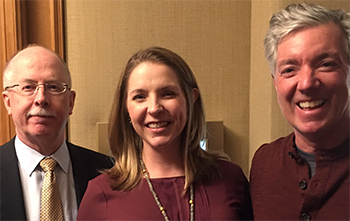As a new ophthalmologist, you’re probably still learning the dictionary’s worth of initials that will affect all of our practices this year. Fortunately, the American Academy of Ophthalmology has a team of expert clinicians and staff dedicated to helping us have a successful year, acronyms and all. Here’s a quick guide to the federal issues and terms that will most affect you and your patients in 2017.
1. MIPS: Merit-Based Incentive Payment System, a new fee-for-service payment option from Medicare. As part of the larger Quality Payment Program, MIPS ties payments to quality and value. MIPS replaces the Physician Quality Reporting System, meaningful use and the value-based modifier. Learn more about how to report for MIPS at aao.org/mips.

Dr. Rhodes joined Academy secretary for federal affairs George A. Williams, MD, and senior secretary for advocacy Daniel J. Briceland, MD, at the January 2017 Federal Affairs Secretariat meeting in Tysons Corner, Va.
2. APM: Alternative payment models, a new approach to paying for the medical care of Medicare patients to incentivize quality and value. This second component of the Quality Payment Program currently offers few qualifying models for ophthalmologists. Learn more about the Quality Payment Program at aao.org/medicare.
3. IRIS® Registry: Intelligent Research in Sight. Developed by the Academy, this clinical registry of eye diseases and conditions helps you measure and improve your performance using data from your EHR system. You can also use it to meet reporting requirements for MIPS. As long as you remain an Academy member in good standing, you can register to use the IRIS Registry for free.
4. CMS: Centers for Medicare & Medicaid Services, part of the Department of Health and Human Services that administers Medicare and Medicaid.
5. OPHTHPAC and Surgical Scope Fund: The Academy’s ophthalmology political action committee represents the profession of ophthalmology as your voice to the U.S. Congress. All Academy members should join OPHTHPAC to help advocate for our patients. On the local front, the Academy’s Surgical Scope Fund ensures that state ophthalmology societies can maintain patient safety and surgical standards at the local level. Contributions from Academy members are 100 percent confidential. The Academy distributes them to state ophthalmology societies to fight legislative and regulatory scope-of-practice battles.
These are just a few of the many federal programs and entities that affect our day-to-day ability to protect the sight of our patients. Luckily, we have many hard-working ophthalmologists and Academy staff to help us digest our alphabet soup. They don’t just work to help us understand acronyms; they get results.
At a recent weekend I spent with the Academy’s federal affairs secretariat, I learned about some of their vital 2016 successes for ophthalmology:
The federal affairs secretariat is comprised of active clinicians devoted to representing ophthalmology’s interests at the level of the federal government. They meet yearly to determine the federal issues most likely to affect our patients and our profession. You can support their work by maintaining active Academy member status. If you’re interested in joining a group like this, learn more about ways to get involved on the Academy website.
Eat up and don’t forget to join OPHTHPAC and make your contribution to the Surgical Scope Fund.
* * *
 About the author: Lindsay A. Rhodes, MD, is an assistant professor of ophthalmology at the University of Alabama at Birmingham School of Medicine. Dr. Rhodes chairs the Academy’s YO advocacy subcommittee and was a member of the Leadership Development Program XVII, class of 2015.
About the author: Lindsay A. Rhodes, MD, is an assistant professor of ophthalmology at the University of Alabama at Birmingham School of Medicine. Dr. Rhodes chairs the Academy’s YO advocacy subcommittee and was a member of the Leadership Development Program XVII, class of 2015.